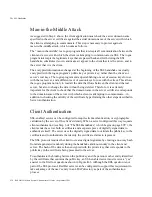
822
Red Hat Certificate System Administrator’s Guide • September 2005
Java Development Kit (JDK)
Software development kit provided by Sun Microsystems
for developing applications and applets using the Java programming language.
Java Native Interface (JNI)
A standard programming interface that provides binary
compatibility across different implementations of the Java Virtual Machine (JVM) on a
given platform, allowing existing code written in a language such as C or C++ for a single
platform to bind to Java. See
http://java.sun.com/products/jdk/1.2/docs/guide/jni/index.html
.
Java Security Services (JSS)
A Java interface for controlling security operations
performed by Netscape Security Services (NSS).
KEA
See Key Exchange Algorithm (KEA).
key
A large number used by a cryptographic algorithm to encrypt or decrypt data. A
person’s public key, for example, allows other people to encrypt messages intended for that
person. The messages must then be decrypted by using the corresponding private key.
key exchange
A procedure followed by a client and server to determine the symmetric
keys they will both use during an SSL session.
Key Exchange Algorithm (KEA)
An algorithm used for key exchange by the US
Government.
Lightweight Directory Access Protocol (LDAP)
A directory service protocol designed
to run over TCP/IP and across multiple platforms. LDAP is a simplified version of
Directory Access Protocol (DAP), used to access X.500 directories. LDAP is under IETF
change control and has evolved to meet Internet requirements.
linked CA
An internally deployed certificate authority (CA) whose certificate is signed
by a public, third-party CA. The internal CA acts as the root CA for certificates it issues,
and the third-party CA acts as the root CA for certificates issued by other CAs that are
linked to the same third-party root CA. Also known as “chained CA” and by other terms
used by different public CAs.
manual authentication
A way of configuring a CS manager that requires human
approval of each certificate request. With this form of authentication, a servlet forwards a
certificate request to a request queue after successful authentication module processing. An
agent with appropriate privileges must then approve each request individually before policy
processing and certificate issuance can proceed.
MD5
A message digest algorithm that was developed by Ronald Rivest. See also one-way
hash.
Summary of Contents for CERTIFICATE 7.1 ADMINISTRATOR
Page 1: ...Administrator s Guide Red Hat Certificate System Version7 1 September 2005 ...
Page 22: ...22 Red Hat Certificate System Administrator s Guide September 2005 ...
Page 128: ...Cloning a CA 128 Red Hat Certificate System Administrator s Guide September 2005 ...
Page 368: ...ACL Reference 368 Red Hat Certificate System Administrator s Guide September 2005 ...
Page 460: ...Constraints Reference 460 Red Hat Certificate System Administrator s Guide September 2005 ...
Page 592: ...CRL Extension Reference 592 Red Hat Certificate System Administrator s Guide September 2005 ...






























